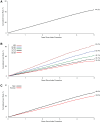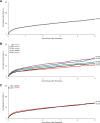Long-Term Clinical Outcomes Following the WATCHMAN Device Use in Medicare Beneficiaries
- PMID: 39364591
- PMCID: PMC11485207
- DOI: 10.1161/CIRCOUTCOMES.124.011007
Long-Term Clinical Outcomes Following the WATCHMAN Device Use in Medicare Beneficiaries
Abstract
Background: Long-term outcomes following left atrial appendage occlusion outside clinical trials and small registries are largely unknown. Collecting these data was a condition of US market authorization of the WATCHMAN device. The aim of this analysis was to evaluate the rates of stroke, bleeding, and death among Medicare beneficiaries following left atrial appendage occlusion implantation during initial commercial availability of the WATCHMAN left atrial appendage occlusion device overall and in important subgroups.
Methods: All Medicare fee-for-service beneficiaries ≥65 years of age who underwent left atrial appendage occlusion from April 1, 2016, to August 31, 2020, were included based on the International Classification of Diseases, Tenth Revision, and Current Procedural Terminology codes. Over a 5-year follow-up period, the cumulative incidence over time of mortality, ischemic stroke, and major bleeding were calculated using the International Classification of Diseases, Tenth Revision, diagnosis codes for the full study cohort and within important prespecified subgroups.
Results: WATCHMAN recipients (n=48 763) were a median of 77 (interquartile range, 72-82) years of age, 42% female, and mostly White (93%). The median CHA2DS2VASc score was 4 (interquartile range, 3-5) with prior major bleeding in 42% and prior stroke in 12%. At 5 years, death occurred in 44%, bleeding in 15% (with higher risk early following implantation), and ischemic stroke in 7%. Each of these end points was more common with greater baseline age. Male patients had greater 5-year mortality than female patients (46.9% versus 40.6%), but there was no difference between sexes in the rates of ischemic stroke (6.6% versus 7.5%) or major bleeding (14.9% for both). WATCHMAN recipients with prior ischemic stroke or a major bleeding event were older and frailer; these groups had higher rates of ischemic stroke, major bleeding, and death.
Conclusions: Compared with patients enrolled in the pivotal clinical trials, Medicare beneficiaries undergoing WATCHMAN implantation were older, more female, and had more comorbid conditions. Substantial long-term mortality and major bleeding following WATCHMAN reflect the high-risk nature of the patient population, while the ischemic stroke rate was relatively low (<1.5% per year).
Keywords: atrial fibrillation; hemorrhage; mortality; stroke.
Conflict of interest statement
Dr Zeitler reports consulting and speaking fees for Abbott, Biosense Webster, Medtronic, and Sanofi; travel support from Abbott, Biosense Webster, and Medtronic; and research support from Biosense Webster, Sanofi, and the National Institutes of Health. B. Bian, B.G., Dr Allocco, Dr Christen, and Dr Roy were full-time employees of Boston Scientific Corporation at the time of this work. Dr Cohen reports research grant support (to institution) from Boston Scientific, Abbott, Edwards Lifesciences, Philips, CathWorks, I-Rhythm, and Zoll Medical and consulting income from Boston Scientific, Abbott, Edwards Lifesciences, Medtronic, Elixir Medical, and HeartBeam. The other authors report no conflicts.
Figures



References
-
- Tsao CW, Aday AW, Almarzooq ZI, Anderson CAM, Arora P, Avery CL, Baker-Smith CM, Beaton AZ, Boehme AK, Buxton AE, et al. ; American Heart Association Council on Epidemiology and Prevention Statistics Committee and Stroke Statistics Subcommittee. Heart disease and stroke statistics-2023 update: a report from the American Heart Association. Circulation. 2023;147:e93–e621. doi: 10.1161/CIR.0000000000001123 - PubMed
-
- Stoddard MF, Dawkins PR, Prince CR, Ammash NM. Left atrial appendage thrombus is not uncommon in patients with acute atrial fibrillation and a recent embolic event: a transesophageal echocardiographic study. J Am Coll Cardiol. 1995;25:452–459. doi: 10.1016/0735-1097(94)00396-8 - PubMed
-
- Black IW, Hopkins AP, Lee LC, Walsh WF. Evaluation of transesophageal echocardiography before cardioversion of atrial fibrillation and flutter in nonanticoagulated patients. Am Heart J. 1993;126:375–381. doi: 10.1016/0002-8703(93)91054-i - PubMed
-
- Orsinelli DA, Pearson AC. Usefulness of transesophageal echocardiography to screen for left atrial thrombus before elective cardioversion for atrial fibrillation. Am J Cardiol. 1993;72:1337–1339. doi: 10.1016/0002-9149(93)90315-4 - PubMed
MeSH terms
LinkOut - more resources
Full Text Sources
Medical
Miscellaneous

